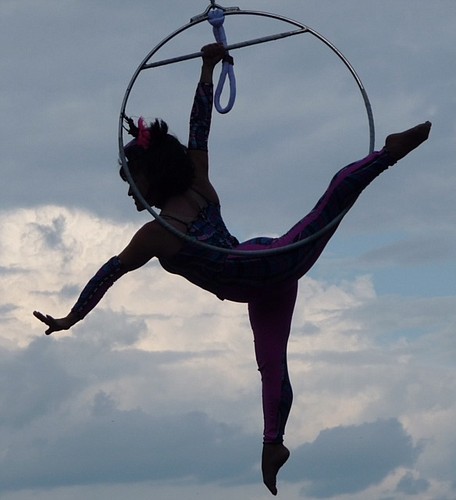- November 17, 2024
-
-
Loading

Loading

Five circus greats are taking their acts to a new ring.
The Circus Ring of Fame to be exact.
Situated around St. Armands Circle, plaques naming circus greats bring pieces of history to the area. This year, The Fredonias, Cedric Walker, Ursula Boettcher, The Ramon Espana Family — The Flying Espanas and Chuck “Chucko” Sidlow will join the ranks.
This year’s induction will take place at 2 p.m. Jan. 13 at St. Armands Circle Park.
Chuck Sidlow was the right kid at the right place at the right time.
Sidlow’s development in the circus world began on Steel Pier in Atlantic City. His grandfather knew the owner of Steel Pier, so Sidlow would help out, but he didn’t notice it was the circus.
Better known as Chucko in the circus world, Sidlow is a first-generation clown. He made his debut with the Ringling Brothers and Barnum & Bailey Circus in 1977 after attending Clown College.
“I didn’t really want to go,” he said. “I didn’t know much about it. I was funny in school, and one of my teachers advised me that the circus was in town, and that I should audition for clown college.”
Sidlow didn’t think he had the necessary performing skills such as juggling or unicycling, but he was funny. Still, Sidlow received a performance contract with Ringling Bros. and Barnum & Bailey Circus and was named “The Youngest Boss Clown.”
Sidlow created Laughter Unlimited, which is now part of the Circus Arts Conservatory. Laughter Unlimited focused on community relations, and to this day, Sidlow continues to visit retirement and assisted-living communities.
“It [the circus] was the engine of Sarasota, and so to include part of the circus back into these people’s lives that they can remember and can share in a brand new memory, it’s overwhelming,” he said.
Despite polar bears having a stereotypically dangerous demeanor, Ursula Boettcher continuously performed alongside them.
Starting in the 1960s, Boettcher’s small size paired next to enormous polar bears wowed crowds in East Germany. The act was part of the Ringling Brothers and Barnum & Bailey Circus Blue Unit in 1976-77 and returned in 1980-1981 after two years at Circus World Florida, the Ring of Fame website said.
She returned to Europe and headlined several circuses. In 1983, Boettcher received the Nice-Matin prize in Monte Carlo, the Ring of Fame website said.
Sherry Powell and John Zamoiski will be speaking on her behalf at the induction.
Carolina Espana Nock and her siblings came to the United States from Mexico with nothing but a dream.
Espana Nock’s oldest brother, Ramon, envisioned incorporating ballet onto the pedestal of the circus.
“He had a dream, and then he really took us with his dream, and then we came to the U.S. and then we worked on the biggest circus and in Europe,” Espana Nock said.
The family act, which includes siblings Ramon “Monchis,” Gladis, Carolina, Irene, Noe and Ivan, created a new standard for trapeze artists. They incorporated ballet and aerial choreography and gymnastic stunts into their act.
The original act with the three eldest siblings came to the U.S. in the mid-1970s following a run with Mexico’s Circo Atayde, the Circus Ring of Fame website said. Throughout the years, other performers would join the Flying Espanas as some of the siblings came and went.
The siblings had a run with Ringling Brothers and Barnum & Bailey Circus, and later they won the silver crown award at Monte Carlo, the Ring of Fame website said.
For the past 25 years, Cedric Walker has been bringing top-notch entertainment to families through UniverSoul Circus.
The Circus Ring of Fame website says it’s one of the most energetic shows on the road.
Walker began his career in the 1970s while touring with the Commodores. He later promoted the Jackson Five, and in the 1980s, Walker organized and
produced festivals and gospel plays, the Ring of Fame website said.
Walker could not be reached for comment.
Alfred Fullgrap was a first-generation circus performer.
He grew up in a small German town where his neighbors were in the circus and he would watch them. One day, the neighbors needed an apprentice, so they asked Alfred’s parents if he could be a performer.
“But my dad was a very aggressive kind of person, so he always wanted his own troupe,” Ilona Fullgrap-Harnas said. “So he started practicing and getting his own apprentices, and then he started the Fredonia family.”
The Fredonias are known for their Risley act in which Alfred would lie on his back and tumble his fellow troupe members with his feet. The Fredonias consisted of Alfred, his wife, Elli, their daughter Ilona, Alfred’s cousin Bernd “Bubbles” Gohlke and Jan Juergen.
After performances with Bertram Mills at the Olympia in London from 1950 to 1951, the group joined Ringling Brothers and Barnum & Bailey Circus and appeared in “The Greatest Show on Earth,” the Ring of Fame website said.
“You have to remember, we didn’t have cellphones, texting, you did what your parents told you, and so we didn’t know any different,” Fullgrap-Harnas said. “This is what we did, and I thought the whole world, I thought every kid lived like I did.”
After leaving the circus in 1960, the group performed for Holiday on Ice.
“I loved the whole thing,” Fullgrap-Harnas said. “It’s odd to explain that when that’s the way you grow up. It’s normal even though it’s not.”
Correction: This story has been updated with Sherry Powell's last name.